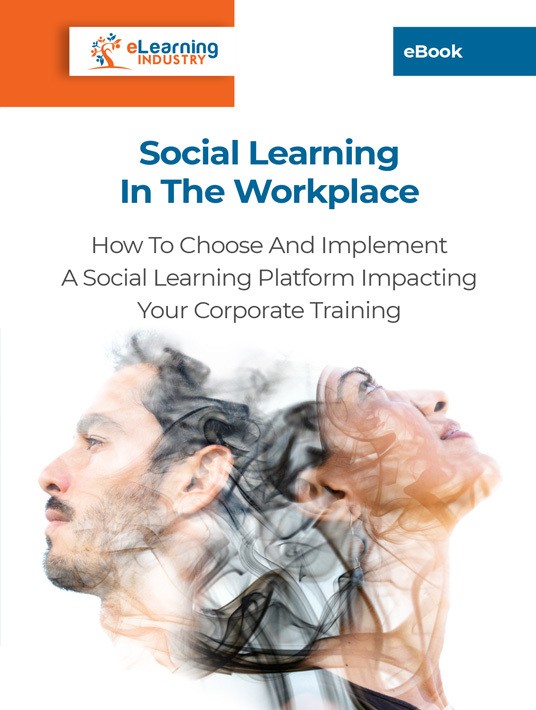Create A Social Learning Program In 6 Steps
In life, we learn a lot of things without actively trying. Like song lyrics or the habits of our family members and workmates. When we’ve spent enough time around these people—or melodies—they slip into our subconscious. And because these aren’t lessons we acquired deliberately, they stay with us longer. We haven’t designated them as "educational." Instead, they’ve attached themselves to our mindsets and thought patterns. This concept makes social learning a valuable corporate training tactic. So how can you formalize your social learning strategy without losing its efficacy for your global workforce?

1. Survey Your Team
The best kind of training is employee-focused. It’s presented in the format they prefer and covers topics they value. By assessing your team and asking the right questions, you can identify skill gaps and workforce development training needs. Then you can tailor online training materials that fit those requirements. As a result, your learners are more invested, so they focus more and put in additional effort. Both of these factors enhance knowledge transfer and retention. Online surveys are ideal because they can be anonymous if needed, and they’re easier to distribute among international teams.
2. Invest In An LMS For Social Learning
Mundane social learning happens organically when people spend time together. But in a work setting, this isn’t always possible. Employee training participants have their own work targets to achieve. So, they may not have the time or space to actively train each other. It has to be deliberately incorporated into their workday. For example, you might have a daily "shadow hour" where the trainer sets aside their tasks and focuses on the employee. An LMS for social learning can help them do this because they can collaborate in a dedicated virtual meeting room. Or even use intranet messaging to schedule and plan their online training activity ahead of time. This way, they can maximize their online training hour and schedule it to suit multiple work rosters and time zones.
3. Identify In-House Talent
The "buddy" system works well for social training. Ideally, there are different skill categories. Some cover areas the employee training participant is interested in on a personal level. Others are things management wants staff to know. In both cases, there are more experienced employees who are already good at said skills. Using the individual online training assessments you carried out earlier, you can spot in-house abilities. For every ten staff members who are proficient at a given skill, you can mark out the ones who teach well. These can be drafted as mentors or coaches, sharing their skills with their colleagues. It can be especially helpful in multi-lingual and multi-cultural settings. Careful trainer selection can help you identify and overcome any regional or geographic impediments to understanding.
4. Evaluate Existing Resources
Of course, not all resources are human—or even corporate. There are lots of other tools that can be repurposed for your social learning strategy. Social media groups, for example. Employees can upload links to videos, articles, or other helpful information they’ve bumped into via the LMS for social learning. They’ll be work-related, but they won’t necessarily be things they found at work. Other examples include real-world anecdotes and case studies. Say a team member attended a client meeting and learned an important lesson. It could be about client preferences or commuting shortcuts. They can casually share this within the social media group. Because it’s off-the-cuff, low-pressure, and unstructured, employees pay more attention than if it was an intimidating memo.
5. Foster The Right Environment
Attitude is everything, so if you don’t nurture a culture of learning, social training isn’t going to work. Try to keep things cordial among your staff. It prevents social learning activities from devolving into show-off sessions. Form groups of like-minded colleagues with different skillsets. If they’re easy-going and they get along, they’ll be more receptive to joint learning opportunities. Also, keep in mind that everyone has a skill, so give them all a turn to shine. If you notice a staff member feeling left out or passive, approach them. Help them identify a unique skill they can share with the group. It makes everyone feel seen and valued, which lowers turnover.
6. Follow Up And Facilitate eLearning Feedback
You can’t just launch a social learning strategy and leave employees to their own devices. They usually need some degree of guidance or support to achieve the desired outcomes. For example, conduct follow-up surveys or quizzes to see how much they’ve learned and detect additional gaps. Provide them with JIT tool to address their areas of concern. Invite their eLearning feedback so that you can solidify your social learning strategy and personalize it to their needs. You should also get input from your L&D team and team managers. Focus on aspects of employee performance that are still lacking so that you can redirect your social learning approach, such as task errors that can be remedied through peer-based coaching or social media groups so that you mitigate risks.
Social learning takes a lot of the pressure off. It allows employees to relax and ease into their studies without feeling dominated. What are some steps you can take to maximize your social training results? Survey your team to identify skill gaps. Get an LMS that’s built with social learning in mind. Review your existing resources—human, technical, and infrastructural—to see what can be used. And make sure you actively develop a healthy learning environment. That’s how you ensure your corporate social learning pursuits produce positive results.
Interested in finding out more about implementing a sound social learning strategy in your organization? Download the eBook Social Learning In The Workplace and discover how to improve workplace performance with an LMS for social learning. Encourage peer-based support and create a workplace environment of trust and mentorship by choosing the right social learning software.








